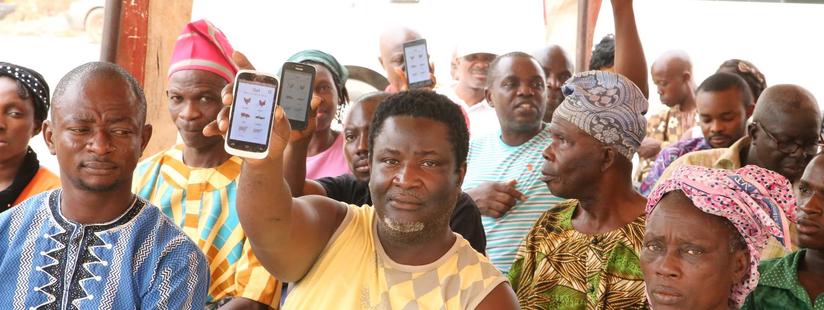 This post is written by David Spielman and Katrin Glatzel, International Food Policy Research Institute
This post is written by David Spielman and Katrin Glatzel, International Food Policy Research Institute
“Digital agriculture” means different things to different people. But for most of us, it means opportunity— opportunity to create new products and services that match farmers with businesses and consumers. This rings loudly in Africa, where digital ecosystems are rapidly emerging throughout the agri-food system, offering smallholder farmers, food-insecure consumers, and nascent agribusinesses with data, tools, and services that did not exist a decade ago.
In many African markets on the farm and along the value chain, digital agriculture solutions are being piloted or scaled to provide smallholder farmers and rural entrepreneurs with a dizzying array of products and services to boost agricultural production and improve their livelihoods: forecasts of weather, pest, and disease threats; services for savings, loans, and insurance; the ”uberization” of mechanization services; and platforms to grade, transport, and sell farm produce. The entrepreneurial spirit in Africa’s emerging digital agriculture ecosystem is cause for excitement and optimism.
But when asked what governments can do to accelerate digital agriculture, our initial excitement often wanes. Of course, we need governments to build the infrastructure required for a digital economy, for example, by allocating and licensing bandwidth in the electromagnetic spectrum so mobile phone networks can expand to the furthest rural corners of a country. But after that, should governments step back, encourage private entrepreneurs to step in, and let market forces flourish with as little public involvement as possible? For many, that seems to be the conventional wisdom.
A report released earlier this year by the Malabo Montpellier Panel (the “MaMo Panel”) digs deeper into this issue, highlighting what some governments across the continent are doing to successfully and sustainably accelerate digital agriculture in Africa. It brings a new perspective to prior conversations on the topic from the Grameen Foundation on digital farmer profiles, the CGIAR Platform for Big Data in Agriculture on clearinghouse on digital innovations in food systems, and many others.
As the MaMo Panel report notes, there are many outstanding examples of forward-looking, innovative public policy, regulation, and investment in digital agriculture in Africa. These examples do not imply that governments must now step back to let digital agriculture thrive. Rather, governments still have a critical role to play. On the one hand the public sector needs to enable an ecosystem in which start-ups, larger private companies, and government-led interventions can succeed. Yet, at the same time, governments must ensure that users of digital agriculture services and tools are not left behind.
For example, governments have an opportunity to apply digital solutions to the provision of agricultural extension and other rural services. These are areas where private entrepreneurs don’t usually rush in to invest because the commercial potential is considered low, especially in highly fragmented smallholder systems and rural markets.
For example, a recent IFPRI study in Ethiopia—conducted under the auspices of Feed the Future’s Developing Local Extension Capacity (DLEC) project and in partnership with Digital Green—demonstrates how the government’s large-scale experiment in video-mediated extension service provision has contributed significantly to technology adoption among smallholder farmers who cultivate cereal staples. If the commodities in question were high-value crops such as coffee, cocoa, fruits, or vegetables, then maybe the private sector would have greater cause to invest in digitalizing—and monetizing—their advisory services. But when the subject matter involves basic food staples, crop management practices, or sustainable use of natural resources, there is often little to attract serious private investment. Several papers in a recent special issue of World Development similarly highlight the role of digital solutions in improving rural governance and the provision of education, health, and water—again, areas where the government plays a central role.
Governments can also invest in digital agriculture by taking on risks that private investors are more reluctant to do. This often takes the form of governments procuring digital services from private companies while shouldering the risks of investing in a sector of the economy that is so heavily exposed to weather and price shocks. It also means investing in the creation of content—through research and education—needed to populate the apps, services, and platforms that service the needs of farmers, entrepreneurs, and consumers. After all, where would all these apps for farmers be without weather data from NASA, price data from national market surveys, or agronomic recommendations from national research and extension systems?
The list of digital products and services in Africa’s agri-food system is growing by the day. But remember that for every M-PESA success story, there is a OneCoin lurking in the shadows. Government regulations may be costly entry barriers to the digital ecosystem for entrepreneurs and can form a byzantine system that allows for corrupt forms of rent extraction. But sensible regulations may also provide users basic safeguards such as the right to privacy and protection of their data, or the right to prevent complex algorithms from masking illegal discriminatory practices. This becomes especially important as more and more resource-poor households are exposed to complex fintech services or mobile apps that can potentially compromise their basic rights. Yet, in 2018, just 23 African countries had data protection and privacy legislation in place while only 11 countries have signed the African Union’s convention on cybersecurity and personal data since 2014.
Finally, governments have a role to play in evaluating—and correcting, where necessary—the effects of digital agriculture on social and economic equity. Because not everyone may benefit from digital agriculture, public policy is key to ensuring that those left on the far side of the digital divide are not excluded. Governments account for this through complex policies on taxation, competition, trade, finance, social protection, and rural development. This renders the opportunities around digital agriculture both exciting and daunting at the same time and calls for cautious optimism.



